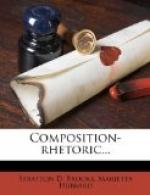3. The mists of the Cuchullins are not fat, dull, and still, like lowland and inland mists, but haggard, and streaming from the black peaks, and full of gusty lines. We saw them first from the top of Beimna-Caillach, a red, round-headed mountain hard by Bradford, in the isle of Skye.
Shortly after noon the rain came up from the sea and drew long delicate gray lines against the cliffs. It came up licking and lisping over the surface of Cornisk, and drove us to the lee of rocks and the shelter of our ponchos, to watch the mists drifting, to listen to the swell and lull of the wind and the patter of the cold rain. There were glimpses now and then of the inner Cuchullins, a fragment of ragged sky line, the sudden jab of a black pinnacle through the mist, the open mouth of a gorge steaming with mist.
We climbed the great ridge, at length, of rock and wet heath that separates Cornisk from Glen Sligachan, slowly through the fitful rain and driving cloud, and saw Sgurr-nan-Gillian, sharp, black, and pitiless, the northernmost peak and sentinel of the Cuchullins. The yellow trail could be seen twisting along the flat, empty glen. Seven miles away was a white spot, the Sligachan Hotel.
I think it must be the dreariest glen in Scotland. The trail twists in a futile manner, and, after all, is mainly bog holes and rolling rocks. The Red Hills are on the right, rusty, reddish, of the color of dried blood, and gashed with sliding bowlders. Their heads seem beaten down, a Helot population, and the Cuchullins stand back like an army of iron conquerors. The Red Hills will be a vanished race one day, and the Cuchullins remain.
Arthur Colton: The Mists o’ Skye ("Harper’s").
+132. Additional Aids to Effectiveness.+—Comparison and figures of speech not only aid in making our picture clear and vivid, but they may add a spice and flavor to our language, which counts for much in the effectiveness and beauty of our description. Notice the following descriptions:—
He was a mongoose, rather like a little cat in his fur and his tail, but quite like a weasel in his head and his habits. His eyes and the end of his restless nose were pink; he could scratch himself anywhere he pleased, with any leg, front or back, that he chose to use; he could fluff up his tail till it looked like a bottle brush, and his war cry as he scuttled through the long grass was Rikk-tikk-tikki-tikki-tikk.
—Kipling: Jungle Book.
Ichabod was a suitable figure for such a steed. He rode with short stirrups, which brought his knees nearly up to the pommel of his saddle; his sharp elbows stuck out like grasshoppers’ legs; he carried his whip perpendicularly in his hand, like a scepter, and, as his horse jogged on, the motion of his arms was not unlike the flapping of a pair of wings. A small wool hat rested on the top of his nose, for so his scanty strip of forehead might be called; and the skirts of his black coat fluttered out almost to the horse’s tail. Such was the appearance of Ichabod and his steed, as they shambled out of the gate of Hans Van Ripper, and it was altogether such an apparition as is seldom to be met with in broad daylight.




